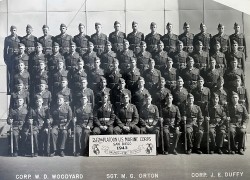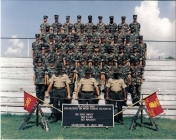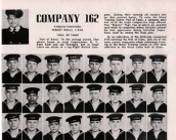The Radiology Specialist is primarily responsible for operating fixed and portable radiology equipment, as well as supervising radiology activities.
68P1O - Skill Level One




Radiology Specialist: Operates fixed and portable radiology equipment. Reads and interprets radiographic requests and physician's orders. Provide patient care within the radiology area. Prepares, assembles and adjusts instruments, materials and equipment. Perform radiographic examinations of the upper and lower extremities, vertebral column, trunk and skull. Performs soft tissue radiographic examinations and bone surveys. Perform body section radiography, foreign body localization, prenatal, pediatric, urogenital and radiographic examinations of the digestive, respiratory, vascular and nervous systems. Develop radiographic image using digital and manual processing. Apply radiation, electrical and mechanical protective measures. Utilizes hospital information systems and performs routine patient administration. Maintain patient locator file, radiographic files and report files. Inspects and performs operator maintenance on radiology equipment. Packs, unpacks, loads and unloads radiology equipment, assembles and dissembles radiology equipment and shelters.
68P2O - Skill Level Two

Radiology Sergeant: Operates fixed and portable radiology equipment. Performs duties shown in preceding level of skill and provides technical guidance to lower grade personnel in accomplishment of their duties. Disseminate radiographic reports. Assembles radiographs for reading. Perform body section, prenatal and pediatric radiographic procedures. Performs follow‑up radiographic examinations of the digestive, urogenital, respiratory, vascular and nervous systems. Assist with special radiographic and fluoroscopic procedures. Requisitions and maintains necessary levels of radiographic/medical supplies. Evaluate radiographic personnel performance. Supervises packing, loading, unpacking, assembly and dissembling of radiology equipment and shelters.
68P3O - Skill Level Three

Radiology Sergeant: Perform complex or specialized radiographic procedures to include duties shown in preceding level of skill or activities medium‑size radiology activity. Inspects radiology activities for compliance with radiation safety procedures and to ensure orderly and clean environment for patients and initiates corrective action. Organizes work schedules. Assigns duties and instructs personnel in technical procedures. Supervise operator maintenance on equipment. Prepares and updates unit and section SOP. Prepares and conducts radiology-training programs. Assist in quality assurance program. Coordinate radiographic examinations of patients.
68P4O - Skill Level Four

Radiology NCO: Supervise large radiology activity. Perform duties shown in preceding level of skill. Establishes work priorities and distributors workload. Reviews, consolidates and prepares technical, personnel and administrative reports. Coordinates and prepare sites for installation of radiographic equipment. Manage0 personnel affairs, supply economy procedures and fiscal matters. Prepare manpower survey reports. Prepare the operating budget for Department of Radiology. Review operations to ensure compliance with Joint Commission on Accreditation of Health Care Organizations (JCAHO) standards.
Platoon Sergeant: The Platoon Sergeant is the primary assistant and advisor to the platoon leader, with the responsibility of training and caring for soldiers. The platoon sergeant helps the commander to train the platoon leader and in that regard has an enormous effect on how that young officer perceives NCOs for the rest of his career. The platoon sergeant takes charge of the platoon in the absence of the platoon leader. As the lowest level senior NCO involved in the company METL, platoon sergeants teach collective and individual tasks to soldiers in their squads, crews or equivalent small units.
Platoon Sergeant: The Platoon Sergeant is the primary assistant and advisor to the platoon leader, with the responsibility of training and caring for soldiers. The platoon sergeant helps the commander to train the platoon leader and in that regard has an enormous effect on how that young officer perceives NCOs for the rest of his career. The platoon sergeant takes charge of the platoon in the absence of the platoon leader. As the lowest level senior NCO involved in the company METL, platoon sergeants teach collective and individual tasks to soldiers in their squads, crews or equivalent small units.
68P5O - Skill Level Five

Senior Radiology NCO: Supervise radiology activity in MEDCEN, large MEDDAC or Combat Support Hospital (CSH). Perform duties shown in preceding level of skill. Instruct in the procedures for developing and conducting training of military and civilian radiographic technicians. Monitor the use, requirement, maintenance and management of resources.
First Sergeant: The First Sergeant is the senior NCO in companies, batteries and troops. The position of first sergeant is similar to that of the CSM in importance, responsibility and prestige. As far back as the Revolutionary War period, first sergeants have enforced discipline, fostered loyalty and commitment in their soldiers, maintained duty rosters and made morning reports to their company commanders. Since today’s first sergeants maintain daily contact with and are responsible for training and ensuring the health and welfare of all of the unit’s soldiers and families, this position requires extraordinary leadership and professional competence. First sergeants hold formations, instruct platoon sergeants and assist the commander in daily unit operations. Though first sergeants supervise routine administrative duties their principle duty is training soldiers. The CSM, first sergeant and other key NCOs, must understand the organization’s collective mission essential tasks during METL-based training. Through NCO development programs, performance counseling and other guidance, first sergeants are the Army’s most important mentors in developing subordinate NCOs.
First Sergeant: The First Sergeant is the senior NCO in companies, batteries and troops. The position of first sergeant is similar to that of the CSM in importance, responsibility and prestige. As far back as the Revolutionary War period, first sergeants have enforced discipline, fostered loyalty and commitment in their soldiers, maintained duty rosters and made morning reports to their company commanders. Since today’s first sergeants maintain daily contact with and are responsible for training and ensuring the health and welfare of all of the unit’s soldiers and families, this position requires extraordinary leadership and professional competence. First sergeants hold formations, instruct platoon sergeants and assist the commander in daily unit operations. Though first sergeants supervise routine administrative duties their principle duty is training soldiers. The CSM, first sergeant and other key NCOs, must understand the organization’s collective mission essential tasks during METL-based training. Through NCO development programs, performance counseling and other guidance, first sergeants are the Army’s most important mentors in developing subordinate NCOs.
School Information
School: 081 School Location: FT SAM HOUSTON, TX
Course: 313-68P10 Phase: 1
Course Title: RADIOLOGY SPECIALIST
Course: 313-68P10 Phase: 1 Course Length: 24 Weeks 0.0 Days
Verifiable Prerequisites
PULHES 222221 Required
Must meet height weight std IAW AR 600-9 YES Required
Normal Red/Green (RG) Perception YES Required
Physical Demand Rating MODERATELY HEAVY - LIFT OCCASIONAL 80 LB, FREQUENT 40 LB Required
Prerequisite Courses
There are no Prerequisite Courses.
Text Prerequisites
Open to Active Army (AA) SPC non-promotable and below, National Guard and Army Reserve SSG (see special information) and below, and DoD civilians. AA and RC soldiers holding MOS 68A, 68K, 68V and 68WM6 will not be considered. The service-remaining requirement (SRR) for in-service AA soldiers upon completion of this course is 29 months, IAW AR 614-200, Chapter 4, Table 4-1. SRR for the RC is governed by NGR 351-1 (4 Years) or AR 135-200 (2 Years). As an exception to policy, USAR Soldiers are TEMPORARILY waived the requirement to fulfill the Ready Reserve obligation upon completion of the course. This policy will be effective for the duration of Partial Mobilization. Soldiers must have a minimum of one year of algebra, high school or college credit, with a "C" grade or higher (9th grade or above). Official high school or college transcripts are required. Enlisted women who are pregnant will be processed IAW AR 635-200. Prior to the departure from home station, soldiers are required to reenlist or extend their term of enlistment in order to fulfill the SRR upon completion of the course. When reporting to the AMEDDC&S for training,and it is determined that soldiers do not meet the SRR, they will not be accepted into the course unless the SRR is fulfilled. The physical profile serials (PULHES) applies to initial entry soldiers only, and is not to be used as a prerequisite for soldiers reclassifying into this MOS. A minimum score of 110 in aptitude area ST in Armed Services Vocational aptitude Battery (ASVAB) tests administered prior to 2 January 2002. A minimum score of 107 in aptitude area ST on ASVAB tests administered on and after 2 January 2002, and prior to 1 July 2004. A minimum score of 106 in aptitude area ST on ASVAB tests administered on and after 1 July 2004. SECURITY: None
Course Scope:
Phase 1 (24 weeks): Provides skill and knowledge training in radiography principles, with emphasis on radiographic procedures, principles of radiographic exposure, radiation protection, imaging equipment and techniques, radiographic film processing, evaluation of radiographs, and quality assurance. Foundational didactics include radiation biology, radiation physics, human structure and function, medical terminology, concepts of patient care, radiographic pathology, medical ethics and law, the role of radiography in the health care delivery system, and computer literacy. This phase includes laboratory practical exercises designed to test the validity of theories and concepts presented in the classroom. Manual skills are developed, refined and evaluated prior to clinical application. Phase 2 (22 weeks): Applicatory clinical training under the supervision of qualified radiographers and radiologists at selected U.S. Army medical facilities.Emphasis is to acquire competency in performing procedures/exams on actual sick and injured patients. Upon successful completion of the course, graduates are awarded MOS 68P.
Special Information:
Reserve Component soldiers will arrive at Fort Sam Houston with the following items MPRJ 201 file, Medical Record, Dental Record and complete basic clothing issue, to include running shoes. DoD civilians must submit a DA1556 requesting attendance at this course. The Unit of assignment for DoD civilians will incur all costs associated with attendance at this course. AA and RC soldiers must submit DA Form 4187, ERB, DA Form 2-1, transcripts, and letters of recommendations from the chain of command. National Guard and Army Reserve SSGs' will receive a certificate of completion for attending this course, additional skill level 30 training is required to be awarded the MOS. SUBMIT ALL REQUESTS FOR WAIVERS TO: CDR, AMEDD Center & School, AMEDD Personnel Proponent Directorate, ATTN: MCCS-DE, 2427 Hood Street, Fort Sam Houston, TX 78234-7584.
Course: 313-68P10 Phase: 1
Course Title: RADIOLOGY SPECIALIST
Course: 313-68P10 Phase: 1 Course Length: 24 Weeks 0.0 Days
Verifiable Prerequisites
PULHES 222221 Required
Must meet height weight std IAW AR 600-9 YES Required
Normal Red/Green (RG) Perception YES Required
Physical Demand Rating MODERATELY HEAVY - LIFT OCCASIONAL 80 LB, FREQUENT 40 LB Required
Prerequisite Courses
There are no Prerequisite Courses.
Text Prerequisites
Open to Active Army (AA) SPC non-promotable and below, National Guard and Army Reserve SSG (see special information) and below, and DoD civilians. AA and RC soldiers holding MOS 68A, 68K, 68V and 68WM6 will not be considered. The service-remaining requirement (SRR) for in-service AA soldiers upon completion of this course is 29 months, IAW AR 614-200, Chapter 4, Table 4-1. SRR for the RC is governed by NGR 351-1 (4 Years) or AR 135-200 (2 Years). As an exception to policy, USAR Soldiers are TEMPORARILY waived the requirement to fulfill the Ready Reserve obligation upon completion of the course. This policy will be effective for the duration of Partial Mobilization. Soldiers must have a minimum of one year of algebra, high school or college credit, with a "C" grade or higher (9th grade or above). Official high school or college transcripts are required. Enlisted women who are pregnant will be processed IAW AR 635-200. Prior to the departure from home station, soldiers are required to reenlist or extend their term of enlistment in order to fulfill the SRR upon completion of the course. When reporting to the AMEDDC&S for training,and it is determined that soldiers do not meet the SRR, they will not be accepted into the course unless the SRR is fulfilled. The physical profile serials (PULHES) applies to initial entry soldiers only, and is not to be used as a prerequisite for soldiers reclassifying into this MOS. A minimum score of 110 in aptitude area ST in Armed Services Vocational aptitude Battery (ASVAB) tests administered prior to 2 January 2002. A minimum score of 107 in aptitude area ST on ASVAB tests administered on and after 2 January 2002, and prior to 1 July 2004. A minimum score of 106 in aptitude area ST on ASVAB tests administered on and after 1 July 2004. SECURITY: None
Course Scope:
Phase 1 (24 weeks): Provides skill and knowledge training in radiography principles, with emphasis on radiographic procedures, principles of radiographic exposure, radiation protection, imaging equipment and techniques, radiographic film processing, evaluation of radiographs, and quality assurance. Foundational didactics include radiation biology, radiation physics, human structure and function, medical terminology, concepts of patient care, radiographic pathology, medical ethics and law, the role of radiography in the health care delivery system, and computer literacy. This phase includes laboratory practical exercises designed to test the validity of theories and concepts presented in the classroom. Manual skills are developed, refined and evaluated prior to clinical application. Phase 2 (22 weeks): Applicatory clinical training under the supervision of qualified radiographers and radiologists at selected U.S. Army medical facilities.Emphasis is to acquire competency in performing procedures/exams on actual sick and injured patients. Upon successful completion of the course, graduates are awarded MOS 68P.
Special Information:
Reserve Component soldiers will arrive at Fort Sam Houston with the following items MPRJ 201 file, Medical Record, Dental Record and complete basic clothing issue, to include running shoes. DoD civilians must submit a DA1556 requesting attendance at this course. The Unit of assignment for DoD civilians will incur all costs associated with attendance at this course. AA and RC soldiers must submit DA Form 4187, ERB, DA Form 2-1, transcripts, and letters of recommendations from the chain of command. National Guard and Army Reserve SSGs' will receive a certificate of completion for attending this course, additional skill level 30 training is required to be awarded the MOS. SUBMIT ALL REQUESTS FOR WAIVERS TO: CDR, AMEDD Center & School, AMEDD Personnel Proponent Directorate, ATTN: MCCS-DE, 2427 Hood Street, Fort Sam Houston, TX 78234-7584.




